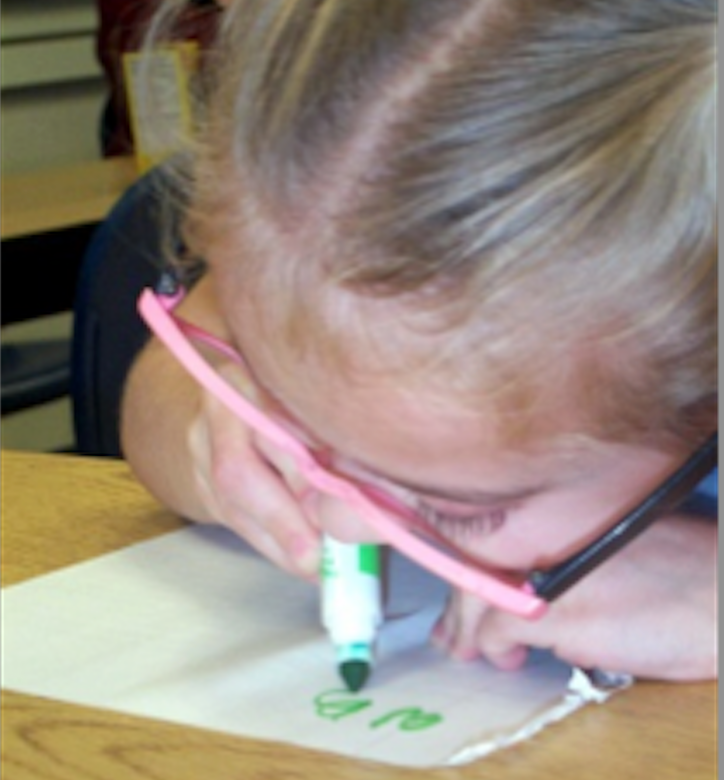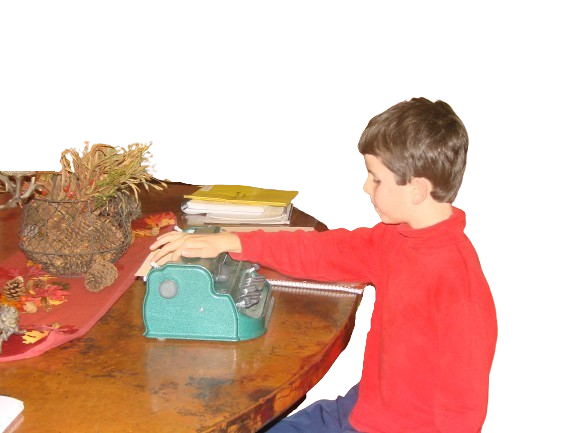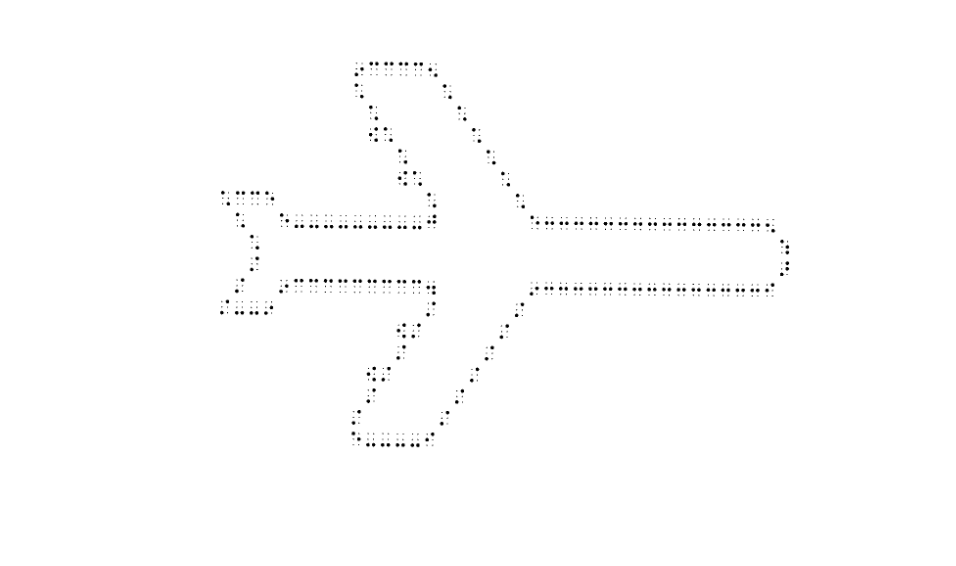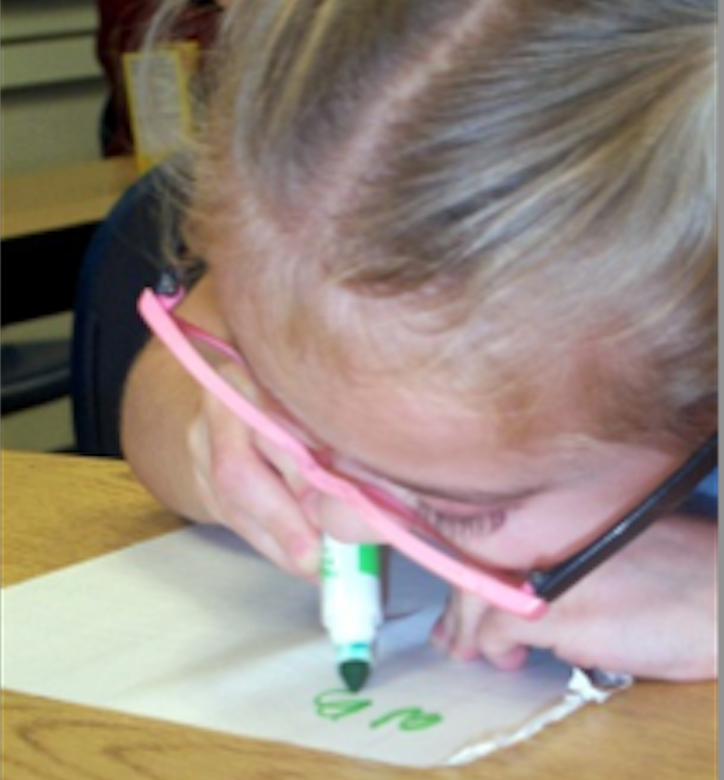 Parents often wonder if their child who has a significant visual impairment should learn braille, print, or both literacy media at the same time. They also question what role audio materials (e.g., books on CDs or downloaded to a special device) should have in their child’s education. They may get perplexed when the teacher of students with visual impairments (TVI) recommends that their child who has been reading print now start to learn braille. Or, they may find it upsetting that the TVI is teaching their child braille, yet their daughter prefers to read print and resists learning to read braille. As a parent it is important to understand the process that the TVI should go through to make the determination if print, braille, or both literacy mediums should be taught to your child. Let’s begin the explanation with an analogy most adults have had first-hand experience with.
Parents often wonder if their child who has a significant visual impairment should learn braille, print, or both literacy media at the same time. They also question what role audio materials (e.g., books on CDs or downloaded to a special device) should have in their child’s education. They may get perplexed when the teacher of students with visual impairments (TVI) recommends that their child who has been reading print now start to learn braille. Or, they may find it upsetting that the TVI is teaching their child braille, yet their daughter prefers to read print and resists learning to read braille. As a parent it is important to understand the process that the TVI should go through to make the determination if print, braille, or both literacy mediums should be taught to your child. Let’s begin the explanation with an analogy most adults have had first-hand experience with.
Literacy Decisions Need To Be Made Based On Data.
You’re driving down the road and your car starts to backfire and is driving “rough” when the check engine light comes on. A bit nervous you pull into the nearest garage to report the symptoms and seek help. Though the mechanic may have some strong feelings about what the problem is, after all he has worked on hundreds of cars and seen similar scenarios many times in the past; he doesn’t automatically replace your oxygen sensor or pull out your air filter and put in a new one. Rather he attaches some equipment to your car’s engine that allows him to pinpoint the problem and only do the necessary repairs. When he uses the correct tools to make those repairs he can get the job done quickly and efficiently having you on your way as fast as possible with the least amount of cost (or so you hope!).
How does this analogy relate to your child’s literacy development? First and foremost, literacy decisions need to be made based on data. In the case of the engine equipment is attached that allows the mechanic to get readings that help him diagnose the problem. In the case of your child, the TVI gathers two types of data that aid in the literacy recommendations. These assessments are the functional vision assessment (FVA) and the learning media assessment (LMA). Before the TVI makes her recommendations to you and the other members of the educational team, she should present the results of the FVA assessment, if appropriate, and the LMA assessment.
What Is A Literacy Toolbox?
Another important point to keep in mind is that the mechanic has a toolbox and he can look inside and pick the right tool for the job. The tools he uses to change the oxygen sensor are different tools from those used to change the air filter, though there might be some overlap. Like a mechanic, your child needs to have a literacy toolbox. In this toolbox your child should have many tools that she can choose from based on the requirements of the task. If your child’s primary literacy medium is braille, her toolbox may be filled with a Perkins braille writer, a tablet with refreshable braille display, a slate and stylus, a portable notetaking device, a handheld audio recorder, a laptop computer with screen reading software, and a playback machine for audio books. For a child whose primary literacy medium is print, the toolbox may contain a slant board, bold line paper, a 20-20 pen, a laptop computer with screen magnification software, a tablet, and a handheld magnifier. These are just examples; your child’s literacy toolbox will be unique to her. As she becomes older the tools in the toolbox will expand and change over time. The important thing to keep in mind is that she needs instruction by a qualified TVI to learn to evaluate what tool she needs for the task on hand and to select the tool that will be most efficient for her to get the job done. Some children will have a combination of tools that allow them to use both their vision for print literacy access and their hands for tactual (braille) literacy access.
Functional Vision Assessment
The purpose of the functional vision assessment (FVA) is two-fold. The first is to gather information about how a child who has usable vision sees the world. The second is to make recommendations that will allow the child to use the vision he has more efficiently throughout his day. If your child falls into the 90% of children with some usable vision he should have an FVA. During the FVA the TVI should gather information about your child’s near visual acuity (what he sees within 16 inches of his eyes), intermediate visual acuity (what he sees between 16 inches and 3 feet away) and distance visual acuity (what he sees beyond 3 feet). The TVI will also look at his peripheral fields, what he sees above, below, to the left, and to the right. Additional things the TVI may check include contrast sensitivity (that is, how well your child is able to pick out an object from the background), color vision, eye-hand coordination, and depth perception. The specific items the TVI assesses and the tools used to do the assessment will vary based on many factors including your child’s age, eye condition, and presence of other disabilities in addition to visual impairment.
As a general rule of thumb an FVA should be conducted at minimum every three years. The TVI should conduct an FVA more often if (a) your child has experienced changes in his vision, (b) your child is going to a new environment (school), or (c) your child’s performance (or grades) drop. The TVI will most likely not conduct an FVA if your child only has light perception or object perception. A child who has a small amount of vision can find this very valuable during travel. However, typically a child who has only light perception or object perception will not have sufficient visual abilities to read print as his primary literacy medium.
After conducting the FVA the TVI should prepare a written report to share with all members of the educational team. If your child is in upper elementary school or higher and can understand the information in the report, then the report should also be shared with him. It is important for children to understand the cause of their own visual impairment, how they use their vision, and ways in which they can learn to use their vision more efficiently. If your child has not had an FVA or you do not have a copy of the report and understand what is in it, then it within your legal rights to ask that an FVA be conducted and the findings shared with you.
Learning Media Assessment
The learning media assessment (LMA) goes hand-in-hand with the functional vision assessment (FVA). There are three components to the LMA. The first is to determine how your child accesses information. Does she do this primarily through use of her vision, her touch (called tactual) or listening (called auditory) channels. The second is to find out how she accesses literacy media (e.g., written information, pictorial information) both at near (less than 16 inches) and distance (beyond 16 inches). If your child already has some reading and writing skills the third component is to assess how efficiently she does this. The TVI will assess your child’s ability to decode (sound out words) and to read passages (silently and aloud) and answer comprehension questions about what is read. If your child uses optical aids (e.g., handheld magnifier, closed circuit television), reading with and without these devices will be examined as will how the size of the print impacts reading. The TVI may also look at your child’s handwriting (e.g., how legible is it, can your child read back what she wrote) and her use of technology (e.g., can she read what is on a computer screen).
Once all the data is gathered, the TVI prepares a report that summarizes all of the information and makes recommendations related to the type of literacy program your child should be participating in. The types of information included in the report and the types of recommendations made will be dependent on your child’s age and the presence of other disability conditions. Not every decision will be made for every child. The decisions to be made include:
- Should the child have a functional or academic literacy program? If your child is young or has additional disabilities, the TVI will gather data to help determine if your child needs a functional, more individualized, literacy program or an academic program typical of that of same age peers.
- Should the child have a literacy program that focuses on visual access to information or tactual access to information or a combination of both?
- At what grade level should instructional materials be presented? At what grade level should recreational materials is presented?
- What role does auditory information (e.g., books on CD, teacher’s talking) play in the child’s access to literacy information?
The TVI will also make recommendations on how to set up the environment so that your child has optimal success when it comes to literacy tasks. For example, your child may read material presented on a slant board with a handheld magnifier more efficiently than she reads materials that are presented in large print. The results of the LMA and the recommendations should be shared with all members of the educational team including your child when appropriate.
Why Would Both Print and Braille Be Appropriate for my Child?
For some children the literacy medium decision – print or braille – is easy to determine, but for others there is a question as to which is “better” for the child to learn or if the two should be learned “together.” There are no hard and fast rules for making these determinations. The educational team should examine results of the functional vision assessment and learning media assessment to help guide them in their decision making. If there are not recent assessments (within a year) then the TVI should conduct thorough assessments and prepare reports to share with all team members. Be sure that you thoroughly understand the TVI’s findings and the recommendations he or she is making. If you question anything in the report, don’t be afraid to ask for clarification or for a review by the TVI’s supervisor or another TVI in the school or agency.
A child might learn both print and braille for several reasons. Probably the most common reason is that the child has a progressive eye condition that has a strong possibility of having the child experience a decrease in vision at some future point. The TVI may recommend that the child begin to learn braille so that he is in a better position to transition into braille being the primary way he reads and write if his vision has a drastic change. The educational team may be looking ahead at the child’s future and seeing that his current print reading rate is slow compared to sighted peers. Knowing that as children get older the amount of reading and writing they are required to do increases significantly, the TVI may recommend that braille instruction occur so that as the visual demands of print reading and writing increase, the child can use braille as the primary way to access information.
Unfortunately, there have been some situations in the US where a child would benefit from braille instruction and is not receiving it because there is not a qualified TVI to provide the braille instruction and/or the TVI doesn’t have enough time to dedicate to braille instruction. If you believe your child should be receiving braille instruction and he is not, question the reasons why braille instruction is not being provided. Ask that a functional vision assessment and learning media assessment be completed. Look carefully at the reading speed reported for your child, how quickly he fatigues when asked to read large quantities of print (sustained reading), and his comprehension. Speak with your child’s general education classroom teacher about how your child’s reading speed and comprehension compare to other children in the class. If you are told your child is reading much slower than peers and/or understanding less of what he reads, it is possible he is spending too much time trying to access the material visually and therefore isn’t getting through it and/or isn’t understanding what he reads because of the tremendous effort he is putting forth to access the information.
What is the Role of Audio Access?
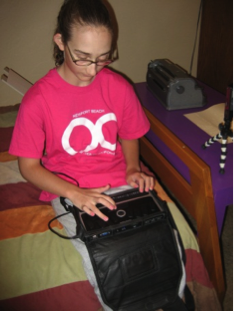 There are some adults who are visually impaired who went through elementary, middle and high school listening to information rather than reading it themselves in print or braille. They took their tests by having them read to them and giving their answers orally. Though we see less of this happening today, it is still possible that your child might have a literacy program that doesn’t give your child either instruction and access in print or in braille. If this is the case this should most likely be a concern to you. Many will argue that if a child doesn’t have a way to access written information (be it in print or braille) and solely relies on listening alone, the child is illiterate.
There are some adults who are visually impaired who went through elementary, middle and high school listening to information rather than reading it themselves in print or braille. They took their tests by having them read to them and giving their answers orally. Though we see less of this happening today, it is still possible that your child might have a literacy program that doesn’t give your child either instruction and access in print or in braille. If this is the case this should most likely be a concern to you. Many will argue that if a child doesn’t have a way to access written information (be it in print or braille) and solely relies on listening alone, the child is illiterate.
Audio information, be it through downloads or special playback devices, can definitely help a child who is either a print or braille reader access large amounts of information in a more efficient manner. Crystal, an avid braille reader in 8th grade, uses downloaded books on her Braille Note (a portable notetaking device) to supplement the books she reads in braille. She has both textbooks from Learning Ally (formerly Recordings for the Blind and Dyslexic) and recreational books, including the Twilight series, that she downloads through Bookshare.org. When she has to read a chapter for her social studies class she often will listen to the chapter while she takes notes in braille or on her laptop. She’ll then use her notes as her main source when studying for an exam. In her math class Crystal reads the math problems in her book or on a worksheet her TVI has prepared. If students are allowed to use a calculator, she uses the one built into her Braille Note. Depending on if the math assignment is for individual practice or a grade, she either brailles her answers on her Perkins brailler or she inputs them into her Braille Note and then emails the file to the teacher. If she produces the math on the Perkins brailler, her TVI must then write out the print so her math teacher can grade the assignment. Crystal makes similar choices on what tool to use for a specific assignment as she moves throughout her school day. The important thing to recognize about Crystal is that she doesn’t solely rely on auditory to get her work done.
For a person with a visual impairment having strong auditory skills, to couple with print or braille skills, can be very advantageous. In college your child is going to find it is not as easy to access books in braille or in large print. The amount of reading will be substantially more than it was in high school. Therefore, having skills to use hearing to take in information can be beneficial. As part of your child’s school program ask that the educational team consider some instruction in how to use hearing efficiently to access and gather information. Be sure your child has good note taking skills, including an accurate way to read back information that she wrote down when hearing a lecture. The development of skills to access audio information and to use audio as a back-up or supplemental medium can increase your child’s success academically, in the world of work, and out in the community.
My Child Isn’t Keeping Up with Her Classmates
Though children may be in the same grade in school their academic performance may vary considerably from that of classmates. Not every child excels academically whether they have a disability or not. You may wonder if your daughter isn’t keeping up with classmates because of her visual impairment or if there are other reasons for this lag. If you have concerns about your child’s progress, or lack of progress, don’t be afraid to ask the educational team to come together to make an action plan to address your concerns. Ask that steps be put in place to gather more information and that a date is set for the group to reconvene to discuss the results. You might ask for things such as:
- An updated functional vision assessment and learning media assessment be conducted.
- If your child has some functional vision schedule an appointment with her eye care specialist to evaluate if any changes have occurred with her vision that warrant a change in prescription, additional testing, or an additional eye disease that is impacting her vision.
- Your child may benefit from a clinical low vision evaluation, a more in-depth eye exam by an eye care specialist who can not only evaluate the health of your child’s eyes but who can look at what optical aids (e.g., magnifiers, hand-held telescopes) can assist her to use her vision more efficiently. During the clinical low vision evaluation the use of different types of light, positioning of materials, and other factors that can be altered to enhance your child’s use of her vision are explored.
- A referral to a reading specialist or learning disability teacher can be made for additional testing. It will be important that your child’s TVI work with this professional to be sure that your child has the testing materials in accessible format and that materials that are reliant on vision are not used unless your child can clearly see them and understand them.
- Data can be collected by the classroom teacher or another team member about what your child is doing during structured times when the class is reading and writing and during non-structured time when the class is reading and writing. If your child is “off-task” for much of these times, is unorganized when it comes to locating materials, is not positioned where she can see, doesn’t have a braille copy of what is on the board, etc., this can impact her success in the classroom.
- You can observe your child at home and take your own data to share with other team members. Here are some possible things you might want to record over several weeks. Taking this data multiple times will allow you and others to look for patterns.
- How many words can your child read in a minute?
- How many words does your child read in 10 minutes?
- If you ask her questions about what she reads, can she answer them?
- Can she retell the story to you?
- Can she read directions on packages or games and follow them?
- When she comes across an unfamiliar word does she sound it out, give up, or ask you to provide it?
- When your child writes something down, can she read it back the next day? A week later?
- When you go to the store, a restaurant, a movie theater, etc., what does she read and how close must she get to read it?
Once everyone has gathered as much information as possible and the educational team has come together, it will be possible to review the information and look together at your child’s situation. Your team may decide that she needs more instruction in how to decode (sound out words), needs to have materials presented in a different size font, would benefit from having materials that are more than 200 words in length in audio format so she can listen to them as she reads the material in braille, or that she needs further testing to determine if she has a learning disability. Regardless of the outcome, the important thing is to get the team working together to determine if there is a problem and if so, how everyone can work together to support your child.
Reading and writing are essential skills for success in today’s world. If your child has the cognitive skills to engage in these tasks, then she has a right to learn them from qualified professionals who can work with you and your family to help you child maximize her potential.
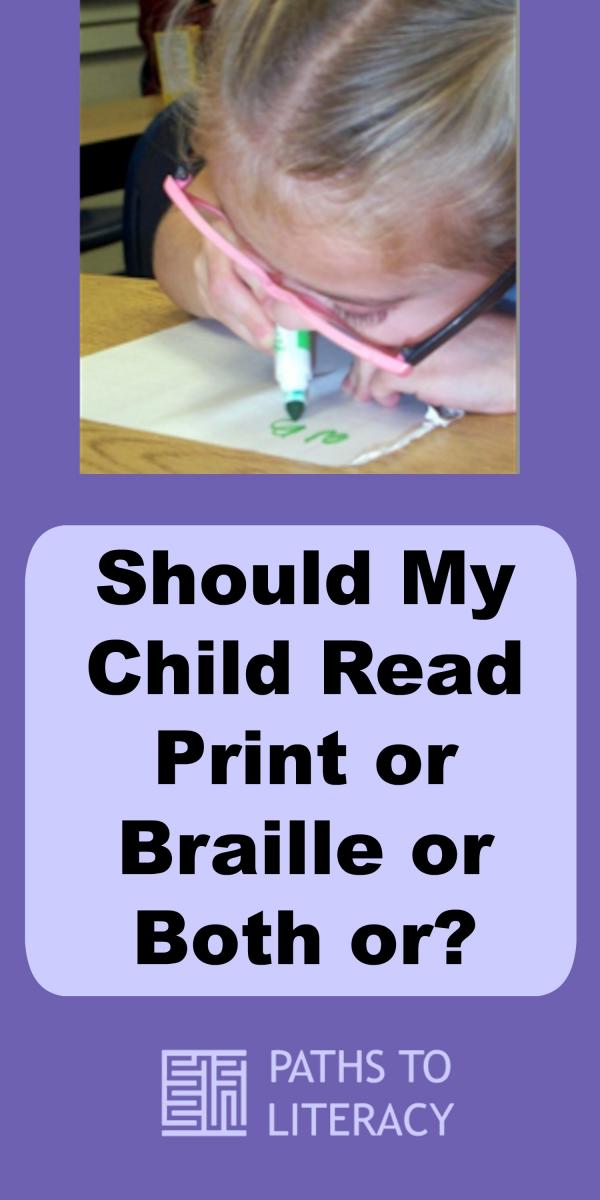
This article was originally posted on the BrailleSC website, which was funded by a grant from the US Department of Education with support from the University of South Carolina Upstate and The Maryland Institute for Technology in the Humanities.

